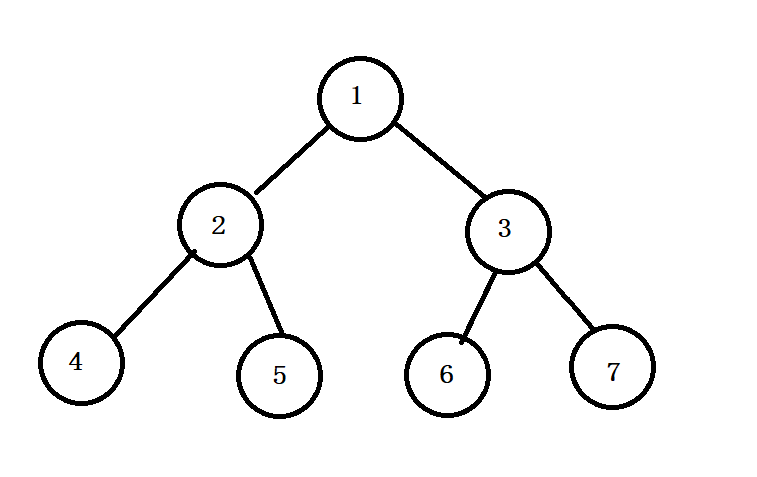java手动构建二叉树并实现广度遍历、深度遍历(前序中序后序)
什么是二叉树
在计算机科学中,树是一种重要的非线性数据结构,直观的看,它是数据元素按分支关系组织起来的结构。二叉树是每个节点最多有两个子树的有序树。通常子树的根被称作“左子树”和“右子树”。二叉树常被用做二叉查找树和二叉堆或是二叉排序树。二叉树的每个节点至多只有两颗子树,二叉树有左右之分,次序不能颠倒。
属性
通常我们使用数的根节点代表这颗树
节点TreeNode
和双向链表相似,二叉树的每个节点也有三个属性值:存储的数据 T data、左子树根节点 TreeNode left、右子树根节点TreeNode right
private static class TreeNode<T>{
T data;
TreeNode<T> left;
TreeNode<T> right;
//默认给出的构造方法只含有数据,左右子树都为空
public TreeNode(T data) {
this.data = data;
}
}
手动构建如下所示二叉树

public static void main(String[] args) {
/*
* 创建树节点
* */
TreeNode<Integer> root = new TreeNode<>(1);
TreeNode<Integer> node2 = new TreeNode<>(2);
TreeNode<Integer> node3 = new TreeNode<>(3);
TreeNode<Integer> node4 = new TreeNode<>(4);
TreeNode<Integer> node5 = new TreeNode<>(5);
TreeNode<Integer> node6 = new TreeNode<>(6);
TreeNode<Integer> node7 = new TreeNode<>(7);
/*
* 手动创建二叉树
* */
root.left = node2;
root.right = node3;
node2.left = node4;
node2.right = node5;
node3.left = node6;
node3.right = node7;
}
遍历
即按照一定的顺序依次遍历整棵树
广度遍历
可以理解为按照层数,依次向下,每层从左到右依次遍历
那么按照定义,上述二叉树的广度遍历结果应该为: 1 2 3 4 5 6 7
算法思想
由于是按照层数遍历,则需要依次遍历每一层并存储每一层的节点,用于下次遍历
即先遍历根节点,再检查根节点是否有左右子树,依次循环
可以使用☞队列来进行==边存边读==
1、把每一层的数据依次存储进去
2、开始遍历上一层的数据,由于队列是先进先出的,所以顺序不会有误
3、在遍历上一层的时候,依次存储上一层节点的左右子树(没有则不存),即一边遍历上一层节点,一边存储下一层节点
实现细节
/**
* @param root: 根节点
* @return void
* decription: 广度遍历二叉树
*/
public static void printByLayer(TreeNode root){
if (root != null) {
Queue<TreeNode> queue = new LinkedList<>();
queue.offer(root);
while (!queue.isEmpty()){
//从队列中取出数据
TreeNode node = queue.poll();
System.out.print(node.data + "\t");
//边读边取
if(node.left != null){
queue.offer(node.left);
}
if(node.right != null){
queue.offer(node.right);
}
}
}else {
System.out.println("当前为空树!");
return;
}
}

深度遍历
根据遍历根节点的先后顺序可以将深度遍历分为三种:先序遍历、中序遍历、后序遍历。核心在于==一个节点就是一棵子树==、==递归==
先序遍历(根左右)
算法思想
简单说就是,一棵树先序遍历要:
1、先遍历根节点
2、遍历左子树左子树还有子树的话,就把左子树看做一颗新树(重复1、2、3)
没有子树就直接输出
3、遍历右子树
右子树还有子树的话,就把右子树看做一颗新树(重复1、2、3)
没有子树就直接输出
那么上述二叉树的先序遍历结果应该为 : 1 2 4 5 3 6 7
实现细节
/**
* @param root: 根节点
* @return void
* decription: 先序遍历二叉树 根左右
*/
public static void pri_print(TreeNode root){
if (root != null) {
System.out.print(root.data+"\t");
if(root.left != null){
pri_print(root.left);
}
if(root.right != null){
pri_print(root.right);
}
}else {
System.out.println("当前为空树!");
return;
}
}

中序遍历(左根右)
算法思想
1、遍历左子树
左子树还有子树的话,就把左子树看做一颗新树(重复1、2、3)
没有子树就直接输出2、遍历根节点
3、遍历右子树
右子树还有子树的话,就把右子树看做一颗新树(重复1、2、3)
没有子树就直接输出
那么上述二叉树的先序遍历结果应该为 : 4 2 5 1 6 3 7
实现细节
/**
* @param root: 根节点
* @return void
* decription: 中序遍历 左根右
*/
public static void mid_print(TreeNode root){
if (root != null) {
//左
if(root.left != null){
mid_print(root.left);
}
//根
System.out.print(root.data+"\t");
//右
if(root.right != null){
mid_print(root.right);
}
}else {
System.out.println("当前为空树!");
return;
}
}

后续遍历(左右根)
算法思想
1、先遍历左子树
左子树还有子树的话,就把左子树看做一颗新树(重复1、2、3)
没有子树就直接输出
2、遍历右子树
右子树还有子树的话,就把右子树看做一颗新树(重复1、2、3)
没有子树就直接输出3、遍历根节点
那么上述二叉树的先序遍历结果应该为 : 4 5 2 6 7 3 1
实现细节
/**
* @param root: 根节点
* @return void
* decription: 后续遍历
*/
public static void last_print(TreeNode root){
if (root != null) {
//左
if(root.left != null){
last_print(root.left);
}
//右
if(root.right != null){
last_print(root.right);
}
//根
System.out.print(root.data+"\t");
}else {
System.out.println("当前为空树!");
return;
}
}

那么简单的二叉树以及其遍历方式就讲解完毕了。关于对二叉树的进一步讲解,请移步来看我的这篇文章☞==二叉排序树==
以上均为本人个人观点,借此分享,希望能和大家一起进步。如有不慎之处,劳请各位批评指正!鄙人将不胜感激并在第一时间进行修改!
- 点赞
- 收藏
- 关注作者


评论(0)